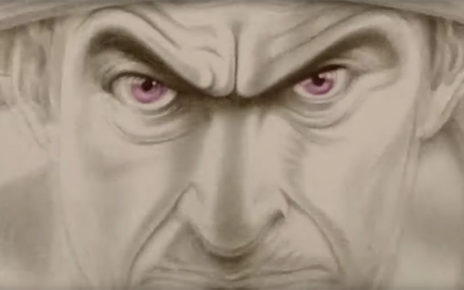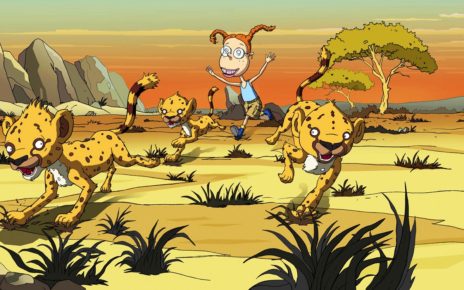Spinel, Steven Universe’s latest antagonist, has had it. That’s right, she’s heard the story over and over again. But this story isn’t swell. It’s the story of the cycle of abuse, a particular form of intergenerational trauma. Although the transmission of trauma from one generation to the next has already been explored in Steven Universe through Steven’s five-season-long discovery of his mother’s broken legacy, Steven Universe: The Movie takes that exploration one step further with Spinel, Pink Diamond’s latest victim and the fandom’s new favorite cinnamon roll.
It’s been well established that the traumas we face change our bodies and our minds. Some people, for example, develop an exaggerated startle response to things like loud, unexpected noises. This physiological process increases the amount of the stress hormone cortisol that runs throughout our bodies, which can increase risk for mental and physical health problems like depression and heart disease. Trauma can also change the way see ourselves and the world around us, and therefore the way we think and act. Self esteem can turn into self hatred, and a once safe world can turn into a funhouse of real and perceived terrors.
These physical, emotional, and behavioral changes can be passed off from one person to the next, through both nature, via epigenetics, and nurture, via interactions with our caregivers, communities, and societies. In many cases, this intergenerational transmission of trauma is not only subtle, but shrouded; one of the symptoms of post-traumatic stress disorder, after all, is an inability to remember significant pieces of the traumatic experiences. Even for people whose brains do not try to protect them by repressing their traumatic memories, many people feel shame about their traumatic experiences and avoid discussing them for fear of judgement. In other cases, the transmission of trauma from one person to the next is crystal clear. And the latter is the type of intergenerational trauma that Pink Diamond passed on to Spinel.
Nothing about Pink’s past excuses her behavior towards Spinel or any of her other so-called friends. The ire that the fandom has spat her way of late is understandable and, for the most part, deserved. But understanding the dynamics of Pink’s relationships provides a context for why she made the choices she did.
Pink was abused and abandoned by her family, the Diamonds. Her sister-moms frequently left her alone on Homeworld while they cavorted around the cosmos, conquering worlds and expanding their purported perfect race. Pink, unlike White, Yellow, and Blue, was not created to be a dictator—she was created to be an entertainer. Her primary role on Homeworld was to throw balls in celebration of the other Diamonds’ accomplishments. With a joke or with a song, Pink became the Diamonds’ own personal entertainment system, distracting them from their often unspoken pain.
Happy to listen, happy to play, Pink served as the mascot in the Diamonds’ disordered family. But the others never really saw Pink; they didn’t know who she really was. When she acted in ways that were aligned with her true sense of self—like when she adopted the technicolor Glo Worms from the kyanite colony—she was locked in a room, again abandoned by the gems who were supposed to be by her side. Through these experiences, Pink may have begun to feel like she was not good enough for them to stick around. She may have even grown to feel unlovable, or undeserving of loving relationships.
People who experience trauma are often unconsciously drawn to recreate parts of these traumatic experiences in an attempt to gain mastery and control over a once-uncontrollable situation. And in Spinel, Pink found a psychodynamic playpen where she could safety re-experience, and make sense of, her trauma.

It’s no coincidence that, in the lead-up to Steven Universe: The Movie, a solid portion of the hiatus-stranded fandom, equipped with only a poster and an abstract promo, theorized that Spinel was an off-color, Era 3 replacement for Pink Diamond. As creepy reboot Pearl explains, Spinel is made for Pink, with the perfect cut and color to boot. She’s designed as a Pink Diamond mini-me, down to her ballooning bloomers, poofy hair, and clownish shoes.
It turns out that Spinel and Pink had more in common than their shared look: Spinel acts like Pink would, if Pink were to guzzle several packs of Fun Dip Amethyst-style. (Side note: are Gems affected by food? Does a cup of coffee energize them? Will an extra spicy order of Drunken Noodles make it “shoot out of them” more quickly than a bland bowl of pasta?) Much like Pink, Spinel was created with the sole purpose of entertaining. She was supposed to be a friend—someone who could, conveniently for the other Diamonds, keep Pink happy and distracted from her campaign to be allowed to conquer.
Although different types of traumas (e.g., war, sexual assault, community violence) can lead to the same problems, there is some evidence that certain types of trauma put us at higher risk for specific of mental and physical health problems. Abuse and neglect, particularly when experienced during childhood, has been shown to be a significant risk factor for the development of borderline personality disorder (BPD).
And there is no doubt that Pink Diamond both abused and neglected Spinel, whether she intended to or not. Pink abandoned Spinel for 6,000 years, leaving her under false pretenses she never owned up to. Pink didn’t just leave her in a random spot, either, but stranded in the garden where they used to play. As a result, Spinel spent those eons haunted by the reminders of a once-happy relationship, her pain triggered over and over again. Sometime during those 6,000 years (as some in the fandom have noted), Spinel began to develop symptoms of BPD.
Intense fear of abandonment
One of the hallmark symptoms of BPD is an intense fear of being left by loved ones. When people with BPD feel they might be abandoned (whether or not that perception is accurate), they may go to extreme lengths to make sure that person stays. In Spinel’s case, her fear of being abandoned is both realistic and understandable, manifesting as a direct replication of the original traumatic event. Even after Spinel is restored to factory settings, being separated from Steven even momentarily elicits an intense emotional response.
Some have argued that Spinel’s original plan to destroy all organic life on Earth was an extreme way of getting Pink Diamond back—that she would have used the injector poison to kill Steven’s human half, and the Rejuvinator to set his gem to Pink Diamond’s original form. Without her memories of her occupation of Earth, her secret identity, and her Crystal Gems, Pink could again go back to a time when Spinel was her one and only best friend—at least, that was Spinel’s hope. But what kind of relationship would Spinel and Pink have?
Unstable relationships
People with BPD often struggle to maintain close relationships. They engage in black-and-white or all-or-nothing thinking, swinging from loving to hating others, sometimes in quick succession. Despite her vibrant hue, Spinel engages in black-and-white thinking about Steven throughout her time on Earth.
Although the first emotional switch was triggered the Rejuvinator, Spinel changes how she feels about Steven even without outside intervention. Softened by Steven’s validation of her experience, Spinel grows to love Steven over the course of the song “Found.” But Spinel’s love for Steven rapidly turns to hate when she incorrectly assumes that he is going to Rejuvinate her once she stops her mega-injector from poisoning the Earth. Fortunately for the world (and for Spinel), Steven helps Spinel step back from her blind rage and help her see that hurting others will not solve her problems. She grows to love him again, but this time it’s more grounded and balanced, which in turn facilitates Spinel’s relationship with the Diamonds.
Inappropriate, intense anger
People with BPD often struggle to regulate and appropriately express high intensity emotions. Some experience intense anger that can get expressed in inappropriate or disproportionate ways. Spinel summarized this symptom best in the middle of her final boss battle with Steven: “I came here to take my anger out on a bunch of strangers, but now that I know you, I want to kill you even more.”
Self harm
The fandom was shocked that the Crewniverse included a line about killing in the movie. Thus far, the threats of physical violence have been well within the limits of the show’s TV-PG rating. But Spinel’s threat to Steven was not the only incidence of violence in this self-contained story arc. Some people with BPD engage in self-injurious behaviors like cutting or burning themselves. Although the reasons for self harming are varied and complex, research has indicated that it is used as a means of emotion regulation and coping with the types of symptoms (e.g., lack of a stable identity) that underlie interpersonal instability.
As the Roundtable theorizes, Spinel may have engaged in self-injurious behavior upon learning that Pink abandoned her for her new friends and the Earth. Aside from Pink, we’ve never seen a gem make permanent alterations to their forms, like their clothing or the orientation of their gem, without poofing first. In the excruciating moments following her traumatic experience, Spinel may have used self harm as a way of numbing overwhelming feelings, perhaps badly enough for her light form to dissipate.

There are many ways to heal—journaling, art, medication treatment, exercise, meditation, and watching cartoons about aliens and humans growing through love and acceptance, to name a few—but the most reparative and effective way to heal from trauma is through supportive relationships. That’s one of the reasons why therapy works: the relationship between therapist and client is one of the best predictors of benefit from the therapeutic process. Engaging in healthy relationships with a therapist, as well as friends, family, or lovers, can help us see both that not everyone will be abusive and that we are all worthy of love.
Though Steven does not have the training needed to be a therapist, he has a preternatural ability to empathize with others. Creating space for pain, validating that pain, and engaging people in reparative relational experiences have the power to heal past wounds. While Pink Diamond never took responsibility for her actions, she left the world someone who could. Steven showed Spinel (and Rebecca Sugar showed the world through this show) that it’s possible to own up to mistakes and to make a change. And through this lesson, Steven stopped the cycle of abuse.
Standard Disclaimer: The information provided in this article is for entertainment and educational purposes only, and is not intended to be a substitute for professional medical advice, diagnosis, or treatment. Always seek the advice of your physician, mental health professional, or other qualified health provider with any questions or concerns you may have regarding a medical condition.
Thanks for reading The Dot and Line, where we talk about animation of all kinds. Don’t forget to follow us on Twitter and sign up for our newsletter.





